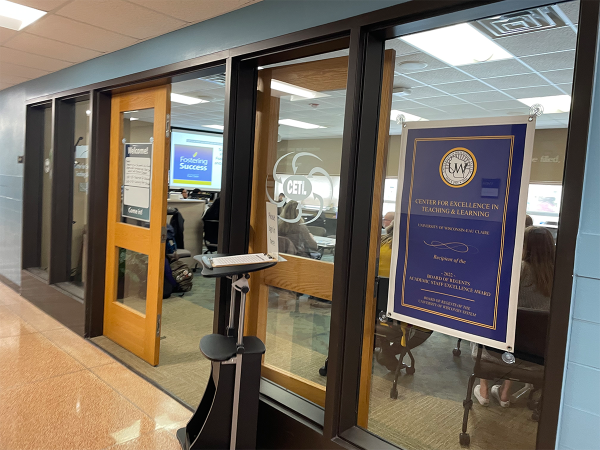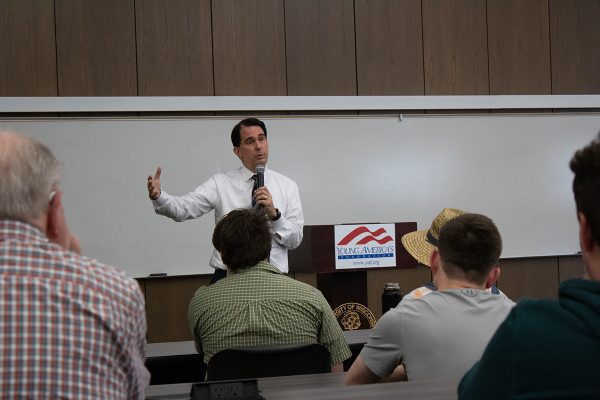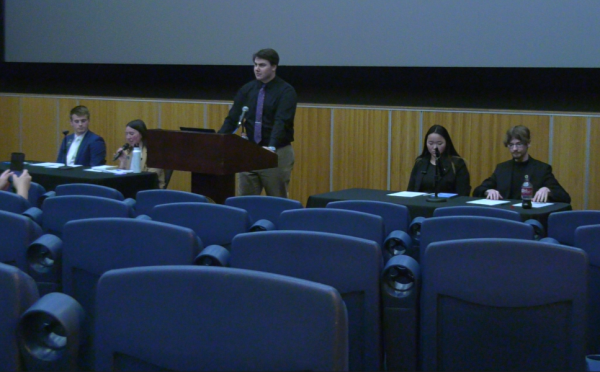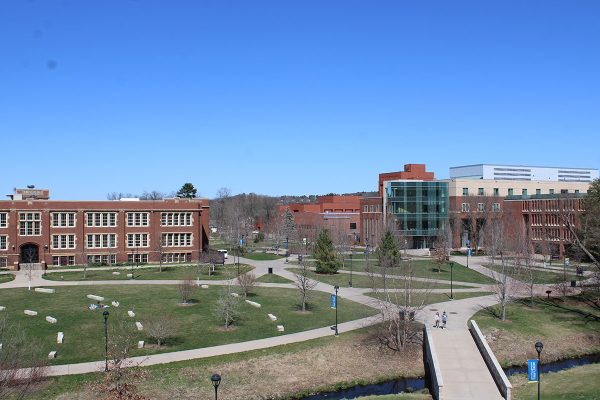No crude, no coal
Local family finds clean energy alternative
SUN SAVINGS: Jim Dickerson built this solar panel array last summer. He’s now running his house on clean energy alone. © 2014 Nate Beck
April 2, 2014
Jim Dickerson strode across cinderblock stepping stones laid out over freshly thawed mud and into his garage.
This isn’t your average lawn mower chamber. Think power plant.
Dickerson, a retired train conductor, sunk his life savings last summer into an array of solar panels mounted on his newly built garage.
The panels, coupled with three 150-foot-deep geothermal heating and cooling pools, generate enough power to earn the Dickerson family a three-month Xcel Energy bill of just $15 in administration charges.
Dickerson’s panels will take about six years for power savings to equal the project’s upfront costs. After that, it’s all profit.
“Just because they’ve been doing it stupid doesn’t mean that you should keep doing it stupid,” Dickerson said.
The Dickerson kitchen counter is scattered with an Allen wrench set and a rechargeable battery dock. He cooks meals on a sun oven — a black box equipped with four reflective panels that focus sunlight on food.
The Dickersons live in a white ranch-style house on the south side of Eau Claire. A wall of six triple-paned windows face south. South-facing windows catch even heat, which is part of the reason he bought the house in 1980.
Since then, he’s slowly been making his house more efficient, adding insulation, installing LED lights and finding ways to trap heat and cut down on energy costs.
Jon Dorn, owner of Dorn Construction in Eau Claire, helped Dickerson build his clean energy project last summer.
Although he’s worked on buildings with clean energy components in the past, he took a lead role in constructing Dickerson’s garage.
“Years ago, solar panels were very expensive,” Dorn said. “I’m not going to kid you, they’re still expensive. But before you’d be lucky if they paid for themselves in their lifetime. Now you can claim full payback in 10 to 15 years. Seems to me they’re catching on strong.”
Dorn said he’s not sure if he’ll live to see fossil fuels evaporate, but it’s good to start planning early.
“Quite frankly I don’t see a way around it,” Dorn said. “There will come a time when fossil fuels will run out and we’ll need to start installing these systems. Either that or move down south where it’s warm.”
Dickerson’s garage is reinforced to withstand tornadoes. The studs in the frame of his garage are laced to trusses. He has a generator in his backyard that can power his house for six months at a time in emergencies.
Dickerson has read books and taken classes about fossil fuel shortages and peak oil, the date when the world’s finite oil supply starts to run dry.
And when we start to run out of oil, energy costs will skyrocket, Dickerson said. People won’t be able to afford sustainable energy.
“I’m just thinking ahead,” Dickerson said. “Everything is based on energy. When people can’t pay their bills because the energy cost is too high, you’re going to see a massive depression.”
In October 1973, the Organization of Arab Petroleum Exporting Countries formed an oil embargo, spurring a gas price spike in the U.S. There were gas shortages nationwide, and by the time OAPEC dissolved the embargo, the price of oil jumped from $3 to $12 a barrel.
So Dickerson wired four batteries from a junkyard to a bus generator and built a motor. That turned into an electric-powered car he used for a senior project. It couldn’t burn rubber, he said, but it was solid enough to carry him a mile each way to school every day.
He’s saving his electric return to trade up his Ford F-150 for a plug-in vehicle. But he’s waiting for something beefier than a Smart Car.
Steve Terwilliger, retired UW-Eau Claire art and design professor, met Dickerson on the Solar Tour, a showcase of local clean energy generators in the region in October.
He also lectures on fossil fuel shortages, renewable energy and transportation. He said it’s only matter of time before people will need to start relying on clean energy.
“It’s an inevitability,” he said. “It’s something as a community and as a country we are going to have to address. Nature waits for no one.”
Dickerson said he’s been trying to make his home run efficiently since he bought his house. But the Dickersons use lots of power, which is why they try to save everywhere they can.
“We’re huge energy users,” Dickerson said. “We cook three times a day. We’re using more electricity than anyone in the neighborhood. … We use a ton of energy, but we’re generating more energy.”
Dickerson doesn’t waste much breath spouting about saving the planet. He’d rather talk about the angle of his overhangs or the spacing of his studs — they’re set at 16 inches by the way, twice as many as a normal house.
But he’s quick to cite a section from “Collapse,” by Jared Diamond, where people of Easter Island depleted the island’s resources to build moai, giant face-like statues.
“What did the last guy say as he was cutting down the last tree? Technology is going to get us out of this one,” Dickerson said with a smirk.











